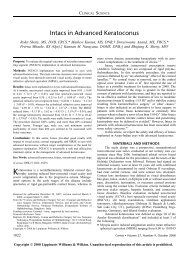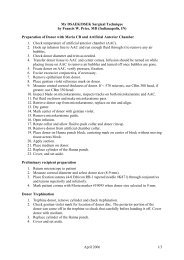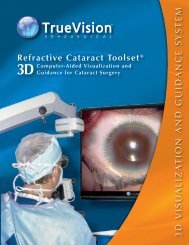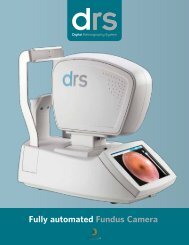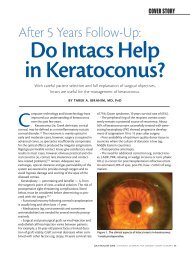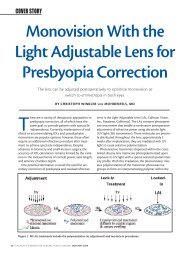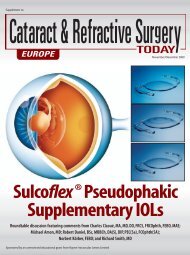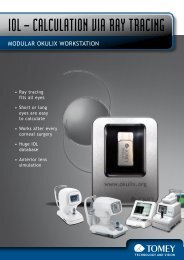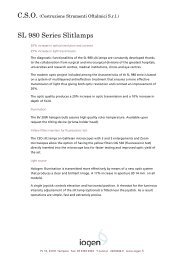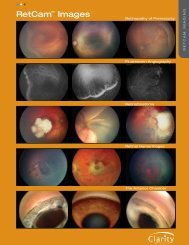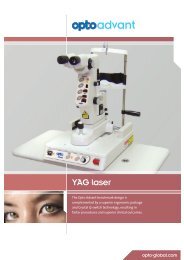Correction of Residual Hyperopia After Cataract Surgery ... - Iogen
Correction of Residual Hyperopia After Cataract Surgery ... - Iogen
Correction of Residual Hyperopia After Cataract Surgery ... - Iogen
Create successful ePaper yourself
Turn your PDF publications into a flip-book with our unique Google optimized e-Paper software.
An important aspect <strong>of</strong> the light adjustable lens is the<br />
need to wear UV protective spectacles until lock-in is<br />
performed. This is because the photoreactive silicone<br />
macromer undergoes photopolymerization when exposed<br />
to UV light. The light adjustable lens has approximately<br />
one hour <strong>of</strong> built in UV protection in the absence <strong>of</strong><br />
sunglasses (Chang SH, unpublished data, 2006), but after<br />
that, there is a risk for photopolymerization and optical<br />
changes. Therefore, patients are instructed to wear the UV<br />
blocking sunglasses until lock-in is completed. <strong>After</strong> lockin,<br />
no UV protection is necessary.<br />
While this study demonstrates precise adjustment <strong>of</strong><br />
hyperopia between 0.25 to 2.0 D, the eye would<br />
require a second adjustment to correct more than 2.0 D<br />
before lock-in. Chemical analysis <strong>of</strong> light adjustable lenses<br />
reveals that photoreactive macromer is available to undergo<br />
multiple photo-polymerization leading to additional<br />
refractive change as long as the lens is not locked-in. In<br />
vitro studies have achieved a 3.5 D power change with<br />
secondary adjustments <strong>of</strong> light adjustable lenses.<br />
The light adjustable lens and digital light device provide<br />
surgeons a means to fine tune refractive power in the<br />
postoperative period. In this small pilot series <strong>of</strong> patients<br />
treated for residual hyperopia, adjustments were precise<br />
and stable for up to six months follow-up. This technology<br />
may provide greater confidence in final refractive outcome<br />
as increasing numbers <strong>of</strong> corneal refractive surgery patients<br />
age and develop cataracts.<br />
THIS STUDY WAS SUPPORTED BY SMALL BUSINESS INNOVATIVE RESEARCH GRANT NO. EY12181-02. DRS SANDSTEDT, CHANG,<br />
Rhee, and Tsuchiyama are Calhoun Vision employees. Dr Chayet is a clinical investigator for Calhoun Vision. Dr Schwartz is the founder <strong>of</strong> Calhoun<br />
Vision with financial interest. Involved in design <strong>of</strong> study (A.C., C.S., S.C., B.T., P.R., D.S.); conduct <strong>of</strong> study (A.C.); collection, management, analysis<br />
and interpretation <strong>of</strong> the data (A.C., C.S., S.C., P.R., B.T., D.S.); preparation <strong>of</strong> the manuscript (A.C., S.C., D.S.); and review or approval <strong>of</strong> the<br />
manuscript (A.C., C.S., S.C., B.T., P.R., D.S.). The clinical trial was approved and registered with Ministry <strong>of</strong> Health, the Secretaria de Salud, No.<br />
204/004209, in Mexico City, Mexico. The studies were approved by Codet Vision Institute Institutional Review Board, Comite De Investigacion y Etica,<br />
in Tijuan, Mexico. The study was performed in accordance with the Declaration <strong>of</strong> Helsinki and all patients gave written informed consent for research.<br />
REFERENCES<br />
1. Pepose JS, Lim-Bon-Siong R, Mardelli P. Future shock: the<br />
long-term consequences <strong>of</strong> refractive surgery. Br J Ophthalmol<br />
1997;81:428–429.<br />
2. Seitz B, Langenbucher A, Nguyen NX, Kus MM, Kuchle M.<br />
Underestimation <strong>of</strong> intraocular lens power for cataract surgery<br />
after myopic photorefractive keratectomy. Ophthalmology<br />
1999;106:693–702.<br />
3. Koch DD, Wang L. Calculating IOL power in eyes that have<br />
had refractive surgery. J <strong>Cataract</strong> Refract Surg 2003;29:<br />
2039–2042.<br />
4. Hamed AM, Wang L, Misra M, Koch DD. A comparative<br />
analysis <strong>of</strong> five methods <strong>of</strong> determining corneal refractive<br />
power in eyes that have undergone myopic laser in situ<br />
keratomileusis. Ophthalmology 2002;109:651–658.<br />
5. Rosa N, Capasso L, Lanza M, et al. Reliability <strong>of</strong> a new<br />
correcting factor in calculating intraocular lens power after<br />
refractive corneal surgery. J <strong>Cataract</strong> Refract Surg 2005;31:<br />
1020–1024.<br />
6. Shammas HJ, Shammas MC, Garabet A, et al. Correcting<br />
the corneal power measurements for intraocular lens power<br />
calculations after myopic laser in situ keratomileusis. Am J<br />
Ophthalmol 2003;136:426–432.<br />
7. Latkany RA, Chokshi AR, Speaker MG, et al. Intraocular<br />
lens calculations after refractive surgery. J <strong>Cataract</strong> Refract<br />
Surg 2005;31:562–570.<br />
8. Gimbel HV, Sun R. Accuracy and predictability <strong>of</strong> intraocular<br />
lens power calculation after laser in situ keratomileusis.<br />
J <strong>Cataract</strong> Refract Surg 2001;27:571–576.<br />
9. Sónego-Krone S, López-Moreno G, Beaujon-Balbi OV, et al.<br />
A direct method to measure the power <strong>of</strong> the central cornea<br />
after myopic laser in situ keratomileusis. Arch Ophthalmol<br />
2004;122:159–166.<br />
10. H<strong>of</strong>fer KJ. Intraocular lens power calculation for eyes after<br />
refractive keratotomy. J Refract Surg 1995;11:490–493.<br />
11. Koch DD, Wang L. Calculating IOL power in eyes that have<br />
had refractive surgery [editorial]. J <strong>Cataract</strong> Refract Surg<br />
2003;29:2039–2042.<br />
12. Masket S, Masket SE. Simple regression formula for intraocular<br />
lens power adjustment in eyes requiring cataract surgery<br />
after excimer laser photoablation. J <strong>Cataract</strong> Refract Surg<br />
2006;32:430–434.<br />
13. Mackool RJ, Ko W, Mackool R. Intraocular lens power<br />
calculation after laser in situ keratomileusis; aphakic refraction<br />
technique. J <strong>Cataract</strong> Refract Surg 2006;32:435–437.<br />
14. Schwartz DM. Light-adjustable lens. Trans Am Ophthalmol<br />
Soc 2003;101:417–436.<br />
15. Schwartz DM, Sandstedt CA, Chang SH, et al. Lightadjustable<br />
lens: development <strong>of</strong> in vitro nomograms. Trans<br />
Am Ophthalmol Soc 2004;102:67–72; discussion 72–74.<br />
16. Sandstedt CA, Chang SH, Grubbs RH, Schwartz DM. Light<br />
adjustable lens: customizing correction for multifocality and<br />
higher-order aberrations. Trans Am Ophthalmol Soc 2006;<br />
104:29–39.<br />
17. Olson R, Mamalis N, Hauge B. A light adjustable lens with<br />
injectable optics. Ophthalmol Clin North Am 2006;19:135–<br />
142.<br />
18. Hayashi K, Hayashi H. Comparison <strong>of</strong> the stability <strong>of</strong> 1-piece<br />
and 3-piece acrylic intraocular lenses in the lens capsule. J<br />
<strong>Cataract</strong> Refract Surg 2005;31:337–342.<br />
19. ANSI Z80.11-2007, American National Standard for Ophthalmics<br />
– Laser Systems for Corneal Reshaping.<br />
VOL. 147, NO. 3 PSEUDOPHAKIC HYPEROPIA CORRECTION<br />
397




